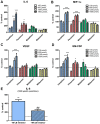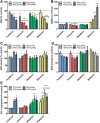Organophosphorus pesticides exhibit compound specific effects in rat precision-cut lung slices (PCLS): mechanisms involved in airway response, cytotoxicity, inflammatory activation and antioxidative defense
- PMID: 34778934
- PMCID: PMC8748323
- DOI: 10.1007/s00204-021-03186-x
Organophosphorus pesticides exhibit compound specific effects in rat precision-cut lung slices (PCLS): mechanisms involved in airway response, cytotoxicity, inflammatory activation and antioxidative defense
Abstract
Organophosphorus compound pesticides (OP) are widely used in pest control and might be misused for terrorist attacks. Although acetylcholinesterase (AChE) inhibition is the predominant toxic mechanism, OP may induce pneumonia and formation of lung edema after poisoning and during clinical treatment as life-threatening complication. To investigate the underlying mechanisms, rat precision-cut lung slices (PCLS) were exposed to the OP parathion, malathion and their biotransformation products paraoxon and malaoxon (100-2000 µmol/L). Airway response, metabolic activity, release of LDH, cytokine expression and oxidative stress response were analyzed. A concentration-dependent inhibition of airway relaxation was observed after exposure with the oxon but not with the thion-OP. In contrast, cytotoxic effects were observed for both forms in higher concentrations. Increased cytokine expression was observed after exposure to parathion and paraoxon (IL-6, GM-CSF, MIP-1α) and IL-6 expression was dependent on NFκB activation. Intracellular GSH levels were significantly reduced by all four tested OP but an increase in GSSG and HO-1 expression was predominantly observed after malaoxon exposure. Pretreatment with the antioxidant N-acetylcysteine reduced malaoxon but not paraoxon-induced cytotoxicity. PCLS as a 3D lung model system revealed OP-induced effects depending on the particular OP. The experimental data of this study contribute to a better understanding of OP toxicity on cellular targets and may be a possible explanation for the variety of clinical outcomes induced by different OP.
Keywords: Bronchoconstriction; Inflammation; Organophosphates; Oxidative stress; PCLS.
© 2021. The Author(s).
Conflict of interest statement
The authors declare that they have no conflict of interest.
Figures






Similar articles
-
Effects of organophosphates on precision-cut kidney slices.Toxicol Mech Methods. 2024 Oct;34(8):855-866. doi: 10.1080/15376516.2024.2356184. Epub 2024 May 23. Toxicol Mech Methods. 2024. PMID: 38745427
-
The Pesticide Metabolites Paraoxon and Malaoxon Induce Cellular Death by Different Mechanisms in Cultured Human Pulmonary Cells.Int J Toxicol. 2015 Sep-Oct;34(5):433-41. doi: 10.1177/1091581815593933. Epub 2015 Jul 14. Int J Toxicol. 2015. PMID: 26173615
-
Organophosphorus pesticides decrease M2 muscarinic receptor function in guinea pig airway nerves via indirect mechanisms.PLoS One. 2010 May 10;5(5):e10562. doi: 10.1371/journal.pone.0010562. PLoS One. 2010. PMID: 20479945 Free PMC article.
-
Does oxidative stress contribute to toxicity in acute organophosphorus poisoning? - a systematic review of the evidence.Clin Toxicol (Phila). 2020 Jun;58(6):437-452. doi: 10.1080/15563650.2019.1693589. Epub 2019 Dec 6. Clin Toxicol (Phila). 2020. PMID: 31810386
-
Blood cholinesterases as human biomarkers of organophosphorus pesticide exposure.Rev Environ Contam Toxicol. 2000;163:29-111. doi: 10.1007/978-1-4757-6429-1_2. Rev Environ Contam Toxicol. 2000. PMID: 10771584 Review.
Cited by
-
High throughput screening of airway constriction in mouse lung slices.Sci Rep. 2024 Aug 29;14(1):20133. doi: 10.1038/s41598-024-71170-3. Sci Rep. 2024. PMID: 39210022 Free PMC article.
-
Organophosphorus Pesticides as Modulating Substances of Inflammation through the Cholinergic Pathway.Int J Mol Sci. 2022 Apr 20;23(9):4523. doi: 10.3390/ijms23094523. Int J Mol Sci. 2022. PMID: 35562914 Free PMC article. Review.
-
Cold storage of human precision-cut lung slices in TiProtec preserves cellular composition and transcriptional responses and enables on-demand mechanistic studies.Respir Res. 2025 Feb 17;26(1):57. doi: 10.1186/s12931-025-03132-w. Respir Res. 2025. PMID: 39962456 Free PMC article.
-
Recent research on Novichok.Arch Toxicol. 2022 May;96(5):1137-1140. doi: 10.1007/s00204-022-03273-7. Epub 2022 Mar 10. Arch Toxicol. 2022. PMID: 35267066 Free PMC article. No abstract available.
-
Precision cut lung slices: an innovative tool for lung transplant research.Front Immunol. 2024 Nov 28;15:1504421. doi: 10.3389/fimmu.2024.1504421. eCollection 2024. Front Immunol. 2024. PMID: 39669559 Free PMC article. Review.
References
-
- Behrsing HP, Furniss MJ, Davis M, Tomaszewski JE, Parchment RE. In vitro exposure of precision-cut lung slices to 2-(4-amino-3-methylphenyl)-5-fluorobenzothiazole lysylamide dihydrochloride (NSC 710305, Phortress) increases inflammatory cytokine content and tissue damage. Toxicol Sci. 2013;131(2):470–479. doi: 10.1093/toxsci/kfs319. - DOI - PMC - PubMed
Publication types
MeSH terms
Substances
Grants and funding
LinkOut - more resources
Full Text Sources
Medical
Miscellaneous

